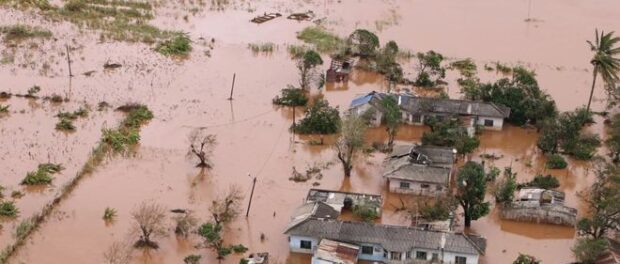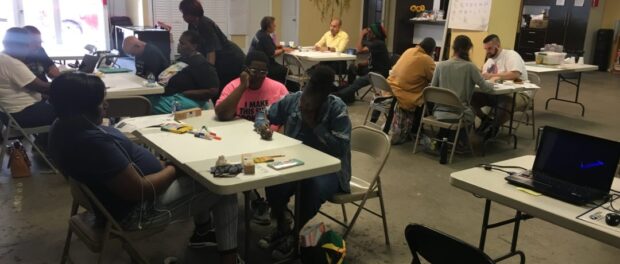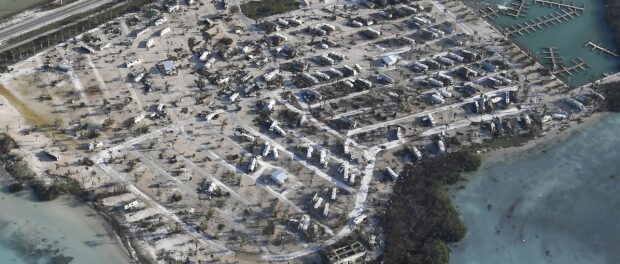
In celebration of the 50th anniversary of New Communities Inc., the world’s first Community Land Trust, and as planners and community members alike gather to celebrate at the Reclaiming Vacant Properties Conference 2019 in Atlanta, Georgia, RioOnWatch issued a call for articles highlighting the current growth of the CLT movement worldwide. Contributors wrote in from around the world, with stories about the expansion of CLTs—both in number and in approach—in Mississippi, the United Kingdom, Belgium, France, Puerto Rico, Rio de Janeiro, and Florida. This varied series aims to disseminate news of the successes of the CLT model as it adapts to new times and circumstances, bringing greater attention to this innovative solution to guarantee the right to housing and community development, and its potential in resolving the global housing crisis.
Today’s final piece, by Priscilla Mayrink, Architecture and Urbanism professor at FAP-CE, Faculdade Paraíso do Ceará, explores the effects of climate change on housing and usage of the CLT as a mitigating tool in Florida.
For more information on CLTs and their potential for Rio de Janeiro’s favelas click here for text and here for video.
Climate change and its ecological impacts are starting to receive the attention necessary to achieve the dramatic shifts needed in human awareness and behavior to respond to the challenge. In cities, impacts of climate in the form of natural disasters are escalating and can no longer be overlooked, as growing urban populations suffer from the direct and indirect effects. In this context, conflicts over access to land and to decent housing are interwoven with environmental collapse.
The negative effects of climate change are not distributed equally across the world’s populations. The lowest income populations, those that inhabit the world’s peripheries and favelas—often minority and immigrant populations—find themselves most threatened by ecological impacts, owing to historical patterns of negligence with these spaces and their location in areas of risk. Changes in climate patterns have shown themselves to be a new component in the dynamics of exclusion and socio-spatial segregation in cities, intensifying housing deficits and complicating access to quality housing.
It is in this context that Community Land Trusts (CLTs) have come to the fore as a new potentially adaptive housing solution to dealing with ecological disasters and the effects of climate change.
CLTs are both being used to deal with scenarios of reconstruction following climate-related disasters, as in the case of the Caño Martín Peña CLT in Puerto Rico and the Florida Keys CLT, and are being used to fight climate gentrification, a new process gaining attention as wealthy coastal communities migrate inland to areas previously occupied by lower income populations, as in case of the Liberty City CLT.
The relationship between climate change and housing deficits manifests itself in two processes. First is the destruction of houses and communities by climate disasters, exemplifying the unequal distribution of negative impacts across territories. This happens because the destruction brought by climate change (floods, hurricanes, etc.) is inversely proportional to local income. The less-resourced the location, the more susceptible it is to climate change and its resulting destruction.
At the same time, processes of gentrification can occur in low-income locations that have been relatively protected from climate impact as people from impacted wealthier areas seek safer ground (and have the resources to move). Climate gentrification can occur through various mechanisms, among them the process of rising values for non-coastal areas and/or elevated areas occupied by low-income populations. In cities experiencing climate risk these areas may be at lower risk of ecological disasters.
The difficulty of reconstruction in disaster-hit areas also influences climate gentrification. In some cases entire families are kept from returning to their homes and reestablishing themselves, a phenomenon that affects low-income families more severely. Areas affected by ecological disasters may suffer from future land value increases through land fraud, the appropriation or purchase of these lands at low prices by real estate agents that promote the reconstruction of the area with improved infrastructure for dealing with environmental impacts, and compounding the damage, a process of local gentrification following the disaster, further raising land values.
In this way, the question of access to land is directly connected with the environment, with land as a speculative good, as individual private property, at center. Thus, solutions for dealing with these scenarios should also, necessarily, examine the relationship of land vulnerability to private property. One of the tools that has been used in cases such as these is the CLT, precisely because of the model’s ability to remove land from speculative pressures and place it in the collective hands of residents of that land. Among other benefits, this action also builds resilience, including resistance to the impacts of climate change.
SMASH Community Land Trust in Liberty City, Miami
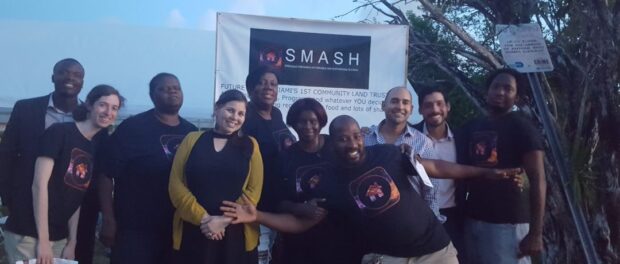
Miami features one of the most severe housing crises in the United States, not only in terms of elevated housing prices, but also due to low household income levels. Many families spend more than 30% of their household income on housing. Black and Latino immigrant families are most affected, since they are generally most susceptible to fluctuations in rent. Miami is also home to some 8,000 homeless people [2016 data] demonstrating the gravity of the region’s housing crisis. Finally, as a tourist destination, the city contains a considerable number of vacation rental properties.
Meanwhile, Miami is one of the cities most at risk of rising sea levels, and is also vulnerable to other climate change-related phenomena, which have their own influence on land valuation and local real estate markets. The outlook is dire: rising sea levels will make coastal areas uninhabitable, intensifying already problematic access to housing, and placing pressure on real estate markets and raising values for elevated and non-coastal areas. A recent study analyzed this process, pointing to a recent pattern towards rising land values and speculative interest for elevated areas, which are less exposed to the consequences of climate change.
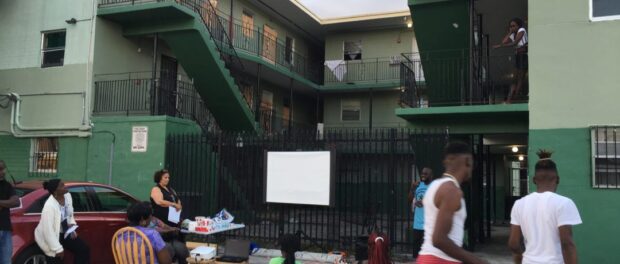
Facing this housing crisis, local residents—of primarily low-income—came together to organize and demand solutions in accessible housing. The Liberty City CLT was born of this process: residents came together to fight against exploitative rent-seeking landowners who had taken advantage of them by offering expensive yet low-quality housing. Liberty City is a neighborhood in Miami characterized by racial segregation, and also one of the lowest-rent neighborhoods—though rent is disproportionately high for the low-income population that lives there.
In 2014, the low-income populations living in low-quality housing in Liberty City began to organize for the right to decent housing, creating a campaign called Smash the Slumlords. According to SMASH (Struggle for Miami’s Affordable and Sustainable Housing), the movement’s beginnings were rough owing to residents’ fears of retaliation from landlords, given they had come to demand real consequences for them, while continuing to occupy their housing. Even so, with time, others began to join in, strengthening the movement and its political clout. They were then able to attain a judicial action declaring that land in the hands of these slumlords would come under local public ownership.
Residents pushed forward, seeking additional lawsuits so landowners would face steeper consequences and for their buildings to be repaired to adequate standards for their families. However, the buildings’ conditions were in such bad shape that the resulting decision was to demolish them and rebuild, resulting in a temporary relocation of these families. Where the families would stay in this period and how they would deal with housing costs in a city with such high prices became an important issue in this process.
As a solution, SMASH decided to build economically accessible housing through a CLT with a focus on the families with the lowest income levels, which are normally excluded from housing projects. These homes would function as temporary relocation, and, later, as affordable housing for other low-income families in similar situations. The Liberty City CLT was thus established with support from the local government.
SMASH gained official control of the land in Liberty City in 2018, making it the Liberty City CLT’s first property and becoming its pilot project. Their goal is to guarantee affordable housing for residents that live in poor conditions, to construct a support house for LGBT youth and a support space for disasters through a local community collective project, which is now in construction. SMASH has also begun a campaign called the Liberty City Committee on Slum and Gentrification, primarily made up of local black residents and working-class residents, in order to organize against processes of gentrification, especially climate change-related gentrification and slumlord activity in the region. If the initial results prove positive, the group will scale the project.
Florida Keys Community Land Trust
The Florida Keys are a chain of islands, extending south of Miami, in an area at high risk of hurricanes. In 2017, Hurricane Irma swept over the Keys, leaving devastation in her path. According to data from the Florida Keys CLT, hurricane Irma destroyed nearly 25% of homes in the Keys, destroying 473 houses, damaging 1,538 on Big Pine Key Island alone. Many residents lost their houses and were forced to live in tents for up to a year after the disaster due to the lack of funding for local reconstruction.
Big Pine Key was home to a large number of social housing projects, demonstrating the disproportionate effect the hurricane would have on low-income families. Many residents possessed no type of insurance, and those that did have insurance did not have sufficient coverage for the level of damage sustained. Many were forced to live in distant areas, far from their places of work. Others began sharing living spaces. The destruction altered the local real estate scenario: the high levels of tourism combined with a context of low housing supply (amid wide-ranging destruction and high demand from residents with no place to live) made the process of finding new housing even more difficult for those affected.
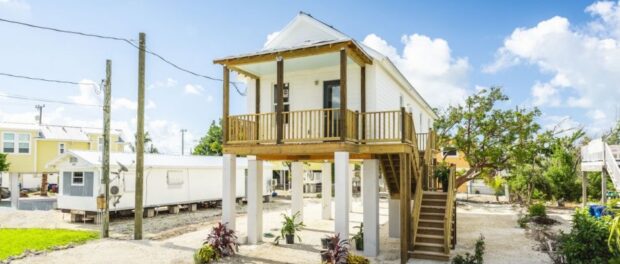
In December of 2017, a CLT was established to attend to the reconstruction of the Big Pine Keys region. But the CLT came about through a process different from that of the SMASH and the Caño Martín Peña model: a wealthy couple donated more than $2 million in order to purchase the land for the CLT and become its founders. The remaining funding was then picked up by other financial contributors, including Monroe county, the Florida Keys Hurricane Foundation, and the Ocean Reef Community Foundation.
In order for the CLT to be established, an accord was drawn up with the Monroe County government so that the lands would be given to families affected by the hurricane for a period of 99 years, keeping a focus on affordable housing. The maximum rental rate for the houses would be set at $1,588 and residents would be, preferentially, from Monroe County. The goal was to make the houses affordable for the short-term, but to allow for the construction of houses to be available for purchase and sale in the future.
The model, born from individual financing, is unusual for the creation of CLTs and there are questions regarding functioning of decisions and CLT administration given that the founders were not residents. In contrast to the Caño Martín Peña CLT and SMASH, where the process of formation and development of local community planning were undertaken in a collective fashion by residents, in the case of Liberty City, decisions are more closely centralized. If in the typical CLT models, the residents are part of the administrative and decision-making bodies, in the Liberty City case, there exists a group of non-residents that control the CLT and that may push for housing construction to be offered to future residents through a selective process.
In February of 2019, the CLT contained nine lots, with the stated aim of constructing hurricane-resistant houses. All lands exist in areas that were destroyed by Hurricane Irma. However, it is not known if future houses will have the same infrastructure quality, given the high construction costs and the construction restrictions imposed by local law in order to deal with climate change. The number of houses constructed is still very low compared to the number of houses destroyed, despite the estimated construction of 20 to 30 homes in the next few years.
This case exemplifies how the CLT model has undergone a process of expansion and flexibilization over the years. However, it is clear that there may be controversy as the model is adjusted, in ways that may compromise its very nature—and the mechanisms that typically make it so successful.
Rethinking access to land and housing based in community organizing is essential, as much for guaranteeing access to affordable housing, the restructuring of areas that have been affected by environmental disasters, and to avoid climate gentrification. In these contexts, the CLT model offers an exciting solution, especially for low-income populations who are more vulnerable to socio-economic inequality and the consequences of natural disasters.
Ensuring housing security (e.g. in the case of CLTs by removing lands from the speculative real estate market) and giving communities control over their development are together essential in assuring that vulnerable populations are not displaced from their homes, and that instead they are able to live in conditions of adequate and improving infrastructure, even in the face of climate change.
This is the seventh and final article in our series on the growth of the global CLT movement. Click here for more.

